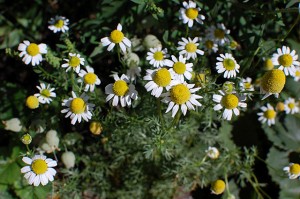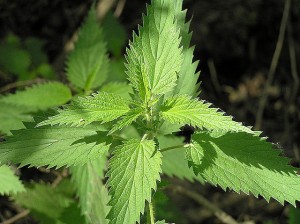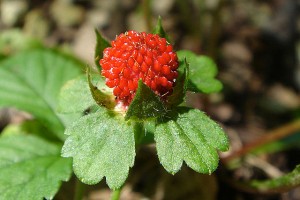Chamomile Tea
Chamomile is one of the most widely used flowers and effective medicinal teas known. The gentle action of this herb makes it suitable for children and adults, and can be safely used on a regular basis. It is widely used for stomachaches, insomnia, sore throats, cramps and teething children. Matricaria recutita, or German chamomile contains the highest concentration of the essential oils responsible for giving chamomile its healing power. The medicinal use of chamomile dates back to the Romans, who relied on its antispasmodic and anti-inflammatory properties. It is also said that the Egyptians dedicated Chamomile to their sun god and valued it over all other herbs for its healing qualities. Except for the small risk of allergy, Chamomile is one of the safest herbs to use.
Photo by Justin and Elise
Preparation of Tea:
- In a teapot, place 1 tsp. of chamomile flowers per cup of water.
- Boil the water, then let it cool slightly (using boiling water will cause the various therapeutic compounds in chamomile to evaporate).
- For best results, steep the tea less than 5 min.
- The healing effect of chamomile is primarily due to the chamazulene and alpha-bisabolol in its essential oil.
- Chamomile has analgesic, anti-inflammatory, antispasmodic and antibacterial effects.
- It calm the nerves and induces sleep.
- Chamomile tea can be used in healing compresses or added to bathwater.
- The essential oils in chamomile combined with other ingredients, such as sulfur and calcium, help relieve gastrointestinal inflammation.
- To ease pain and stimulate the digestion, drink 3 or 4 cups of freshly prepared tea daily for a period of several weeks.
- The flavonoids in chamomile tea can prevent gas and relieve cramps.
- For menstrual cramps, a chamomile tincture is better because its flavonoid concentration is a third higher than that of the tea.
For eye problems:
A Chamomile tea compresses helps relieve eye pain, eye strain and eyelid inflammation.
- Soak 2 cotton pads in lukewarm tea and place them on the eyes for a few minutes.
For inflammation, restlessness and insomnia:
A chamomile tea bath provides quick relief from skin inflammations, restlessness and insomnia.
- Add 1 qt. of chamomile tea to a bathtub full of warm water.
- For insomnia, take the bath before bedtime.
A chamomile tincture can alleviate menstrual cramps.
- Add 2/3 oz. of chamomile flowers to 1 ½ oz. of 100 proof alcohol and let it steep for 1 week.
- Strain and store in a dark vial.
- Take 10 drops in a glass of water.
The germicidal effect of a chamomile vapor helps destroy the germs that cause flu and alleviates coughing.
- Pour 2 qt. of hot water over 2 cups of chamomile flowers.
- Cover your head with a towel and inhale the vapors.
Healing Tea mixtures:
For gastric complaints:
- 1 oz. chamomile
- 2/3 oz peppermint
- 1 oz. caraway seeds
- 2/3 oz. angelica
For Cystitis:
- 1 oz. chamomile
- 1 oz. yarrow
- 1 oz. sage
For skin problems
- 1 oz. chamomile
- 1 oz. dandelion
- 2/3 oz. fennel
Warning: Chamomile has been known to cause allergic reactions in people who are allergic to ragweed or other members of the daisy family.
References:
- The Complete Guide To Natural Healing
Thanks for stopping by! Well wishes to you all and have a great day!

